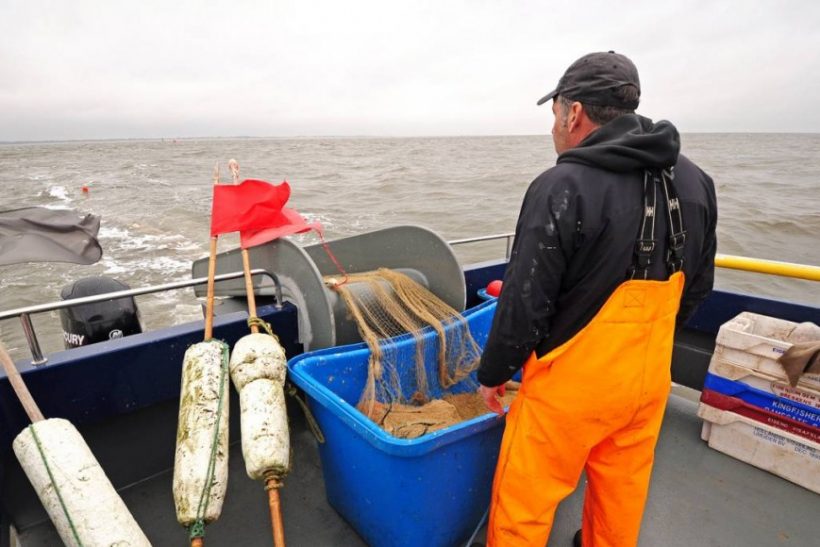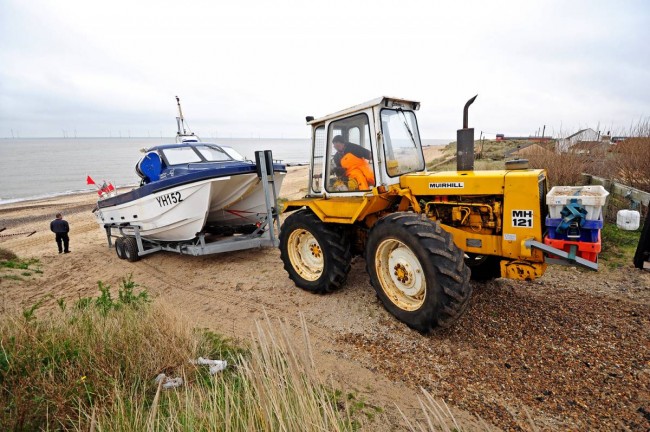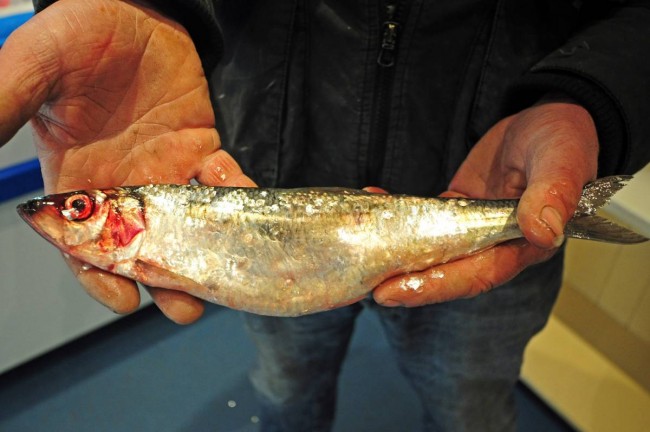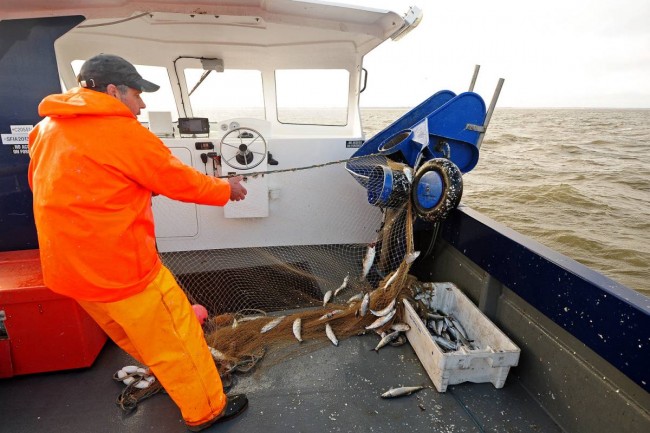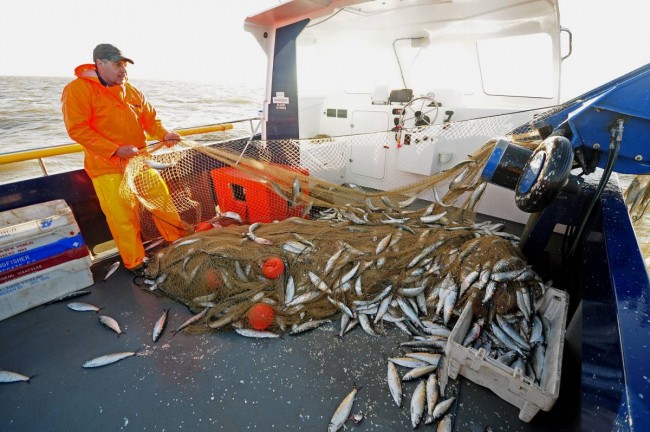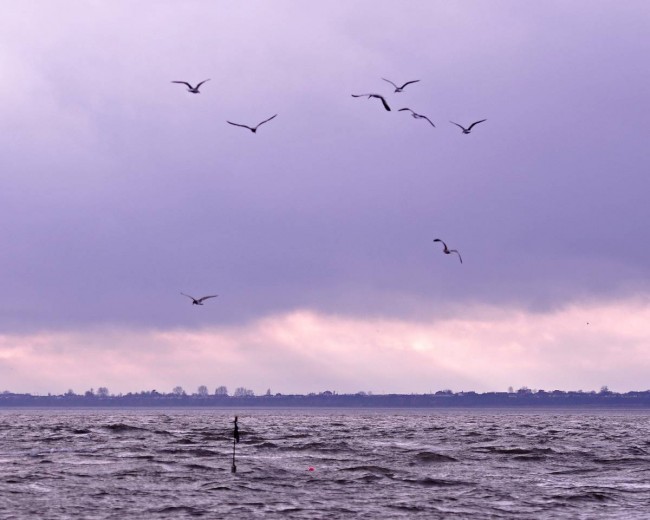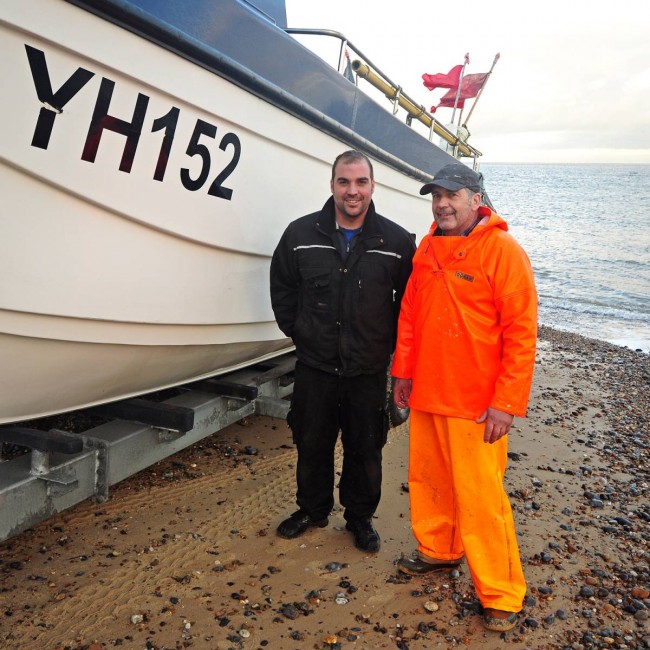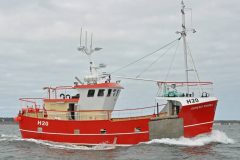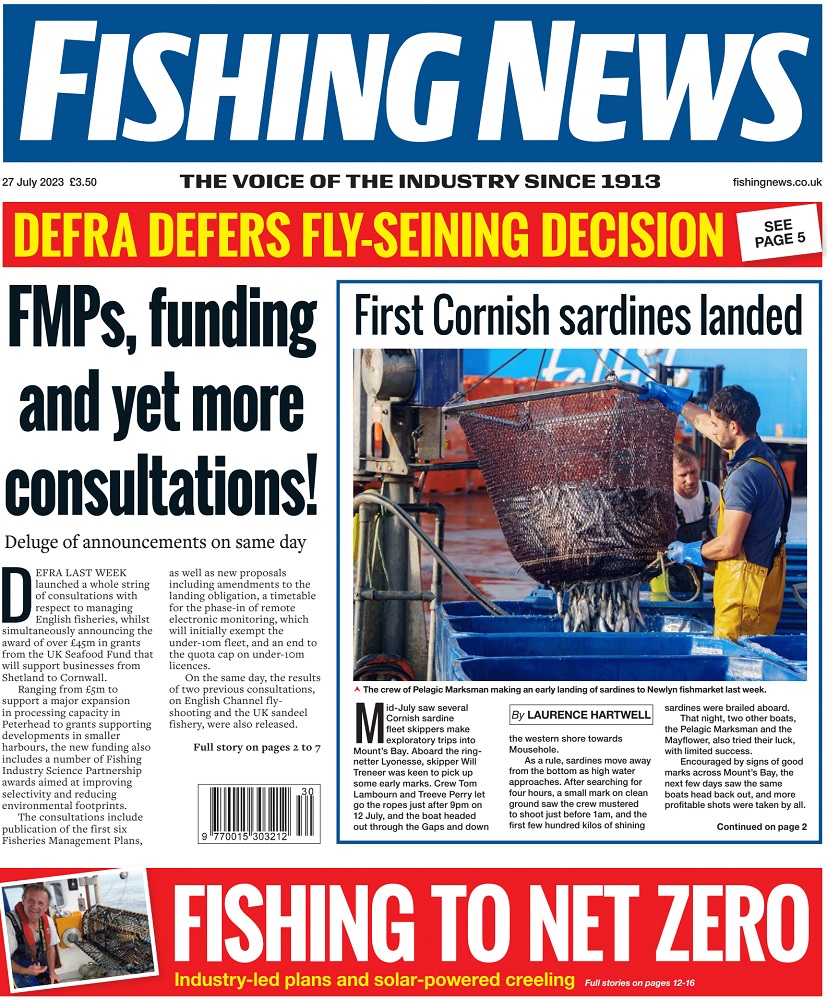For decades the East Anglian herring drift-net fishery was one of the mainstays of the year for UK fishermen and shore workers. Although the heady days of the renowned ‘Hame fishery’ are now consigned to history, herring still gather on the local banks in the late autumn/early winter each year to give a localised small-scale fishery. John Worrall recently launched off the beach at Caister with skipper Paul Williams on the 9m catamaran Charlie George, to report on the Norfolk longshore herring drift-net fishery.
Above: A couple of miles out, Paul Williams shoots the net on the edge of the Scroby Bank.
A nice set-up
Tucked behind the marram dunes at Caister-on-Sea, just north of Great Yarmouth, are a house, smokehouse, freezer unit, lobster tanks and large two-storey workshop, all within a yard big enough also to take pots, nets and other gear, family vehicles and a 9m Cheetah catamaran, Charlie George LT 152, with its trailer and tractor, and still leave room for a gaggle of geese to waddle about.
Fisherman Paul Williams does not have far to go to work; he just backs the catamaran over the dune and onto the beach, although launching needs help from his son, Thomas, who sometimes fishes with him but mostly runs the family garage business down the road. And even the beach is accommodating, with enough slope to get the inshore boat into the water without getting the tractor wet, which is no small consideration in tractor life-expectancy. Beachwork may always be a final career move for a second-hand Muirhill but they still don’t come cheap these days, whatever their condition.

Caister fisherman Paul Williams doesn’t have far to go to work – he just backs the catamaran Charlie George…
Paul does lobsters, some winter long-lining, a few summer bass – for now, anyway – and herring. Particularly herring, because this is traditional herring ground which, until the early 20th century, made Great Yarmouth and Lowestoft the finale of the annual North Sea fishery.
The pattern back then was for the drifter fleet – and the fisher-girl packers and gutters – to follow the herring south from the summer grounds off Scotland, down to the southern North Sea in the autumn. Before the First World War, the autumn peak saw a thousand or so drifters working from Yarmouth, and 600 more from Lowestoft, all hauling the ‘silver darlings’ that, in 1913, amounted to a record 824,000 cran (a cran loosely equivalent to 37.5 imperial gallons) landed at Yarmouth and 536,400 at Lowestoft.
It couldn’t last, of course. A heated debate had already started about non-selective trawlers getting in on the act in these shallow waters, hammering the juvenile stock and threatening the whole business, but then war broke out and quickly brought the sinking of fishing boats by enemy action. It also curtailed the pickling sector, which had been absorbing the larger part of the catch, mostly for export to Germany and to Russia through Germany.
Herring never got back to anything to like that level because of stock depletion and changing consumer tastes (in the UK, anyway, although it remained – and remains – popular in eastern Europe), which was a shame because the nutritional value of this environmentally-friendly product, with all that lovely omega-3, is unchanged.
Species recap
We are talking Atlantic herring, Clupea harengus, one of three herring species on the planet, and one of the most abundant fish in the world, congregating in huge schools sometimes of several cubic kilometres which, they reckon, equates to several billion fish (but at that level, who’s counting?) across the North Atlantic. They are the dominant converter of plankton into fish meat, eating copepods, krill and small fish and being eaten by seals, whales, cod and most other significantly bigger sea creatures fast enough to catch them.
Their survival in such large accumulations is generally put down to the speed – up to four feet per second – at which they cruise, and to their much higher escape speeds. This momentum is allowed by a precise inter-fish spatial arrangement which also gives predators their own wide berth – though to limited effect, obviously, or the food chain would break down. Their journeys in the open sea tend to follow a triangular pattern, thus avoiding double-backs that might see their non-discerning palates consuming their own larvae.
There are three main sub-species of Atlantic herring in the North Sea, spawning in different places and times of the year: some off the Scottish and Shetland coasts during August and September; others in the central North Sea from August until October; and others again in the southern North Sea from October until roughly the turn of the year. One further, more localised, stock, the Thames and Blackwater herring, spawns in the spring. For most of the year the different populations mix, but migrate to their separate areas to spawn. Herring reach maturity at between two and four years, females depositing between 40,000 and 70,000 eggs onto gravelly or stony seabed, the vast majority of which will be eaten by predators before they themselves mature.
In the mid-20th century, North Sea stocks suffered a collapse through over-exploitation and poor recruitment, and the fishery was closed in 1977. Although it reopened in 1983, tighter management was deemed necessary in the 1990s.
But now it’s plentiful once again, this ‘longshore herring’, as they call it to distinguish it from the big pelagic fishery, and at the end of November, Paul invited Fishing News along for a look. “About two hours should do it.”
Two hours? Not bad day’s work if you can get it
But that’s how it was, the catching bit, anyway. The gate on top of the dune was swung open, the tractor/ trailer/catamaran combination reversed over and onto the beach, Thomas backed the trailer into the water and the catamaran, drawing only 0.5m or so, quickly floated off.
We weren’t going far, just a couple of miles out, to the north of the Scroby Sands wind farm where the bank drops off and the herring come nearer to the surface as the tide flows over on its northward ebb.
“They’ll be running here for a couple of hours after high tide.”
The water had a bit of colour after a few days of rough weather and that was making daylight fishing more productive, whereas clearer water of the previous week or two had kept the herring deeper during daylight, which made night fishing better.
But night or day, Paul usually works the Cheetah single-handed, going after herring two or three days a week.
“I bought it a couple of years ago, mainly with long-lining in mind, although I did use it for herring last year, even if this particular hauler isn’t ideal for that. I used to do herring with my smaller boat, but that was hand-hauling, and so I decided to use this one again this year. It’s very stable and, with a 3.7m beam, it’s easier to work and to clear and clean all the gear on board. And there’s less banging about; you don’t suffer with your legs on this. When I was talking to Sean at Cheetah Marine about getting one, he asked if I carried much weight and I said I do occasionally. So he advised me to buy a slightly bigger boat and I’m glad I did. They are not cheap but they are good. Plus I like going to sea in this boat anyway.”
In less than 15 minutes, we were over the ground, watching the gannets locating the fish while the seals bobbed about waiting for us to catch their lunch. A few minutes more, and Paul Williams shot a 500-yard fleet of drift nets across the tide with a dahn at each end, orange floats along the line and a 2-inch nylon mesh to take herring gills but its heavy-gauge nylon bouncing everything else, while making for less tangling and thus easy extraction back in the yard.
And then boat and net went with the flow, past California, so named after someone found gold coins in the low cliff at the time of the gold rush in California USA, until, after barely a few minutes, Paul said: “I think our work is done”. He pointed to a rising of the net which had escaped my attention, but then it was probably genetic – his dad worked on the drifters. “As the herring come in, they push the net up.”
But when he hauled and found plenty of fish in the first stretch, he straightaway eased it back in, reckoning there would be more to be had.
And there were. Within an hour, the whole net was back on deck in a herring-filled heap, nearly 600kg of fish. “A good average day” he said, not obviously too nonchalantly, but he hadn’t had to use the other net aboard.
“These herring are in their prime now. From October to at least the end of November, they are full of roe. They come here to spawn, which is why the Yarmouth herring are so good, so rich. But we can fish them nearly all year round, the only months we don’t get them are July, August and September. They seem to lie in this stream the rest of the time. The plankton on which they feed seems to come in here. We even occasionally see basking sharks – they feed on the same stuff.
Paul Williams has had a fish shop in Yarmouth for four or five years, and comments, “I’ll probably sell three boxes of these in the shop tomorrow, and then put some for bloaters, some for kippers and some for red herring which are traditional around here – salted for three days and smoked for six weeks. But I’ll freeze about half this catch and I’ll keep on freezing part of each catch until probably the second week in December and then keep drawing them out all the way until October next year to make kippers. They actually seem to be better for kippering after they’ve been frozen.
“I finished lobstering about three weeks ago, but I’m still buying lobsters in and holding them in the tank because the price goes up so much towards Christmas. I also sell a lot of brown crab but I buy those from Cromer. This is no good crab ground here.”
Cruising back at 15 knots against the tide, almost exactly two hours after launching, with the twin hulls cushioning the chop, Paul rang the garage for his tractor driver. There would still be the clearing and cleaning of the net onboard, back in the yard, but it wasn’t going to be a long day, though the days will be longer as the winter progresses.
“Once the herring are spent – once they’ve lost their roe, probably by about Christmas – I’ll switch to long-lining for some of the time, although I’ll still do a bit of herring; even though they’re not in prime condition in the New Year, there’s still a market and, anyway, they are good for lining bait. I’ll be going out about 15 miles for the lining, after cod and rays, as long as there’s quota. That far will be comfortable in this boat in almost any weather and these twin petrol Suzukis are very economical, we’ll have only used about 20 litres today, and they’ll get me out that far in an hour.”
Not a bad set-up, indeed: yard and house behind the dune, shop in Yarmouth to sell most of the catch, Lowestoft fish market a dozen miles away to shift the surplus and, on the herring, decent catches from two hours at sea.
“In the evening, cormorants come off the Scroby bank and fly over my house” he says, somehow encapsulating the low-impact self-containment of it all.
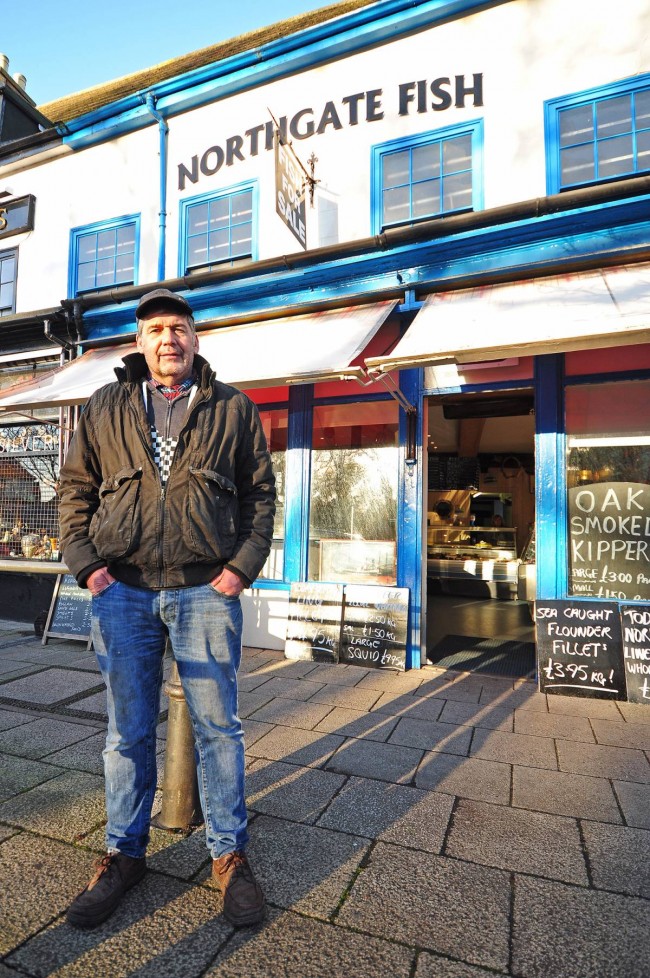
A lot of his catch goes through the Yarmouth shop, housed in a fine Georgian building, which Paul Williams has owned for five years.
But how things will look along this coast a decade from now is a wider question.
Four other fisherman still work from Caister with varying degrees of intensity, mostly keeping their boats in a car park just along from Paul’s place, with access to the beach beside the lifeboat station. They work two-handed but the skippers are getting towards retirement age, like Paul himself, and while it’s hard to see him wanting to retire with a set-up like this, no one goes on forever. There’s only one full-timer now working from Yarmouth, once the port of a thousand drifters.
There may be plenty of herring quota at the moment and the lobsters seem okay, but the bass outlook is uncertain, to say the least, and it remains to be seen how the discards ban will affect long lining. Take out – or even reduce – two of those four elements, and life would be harder for those still doing it, and probably non-viable for anyone wanting to come in. Sure, local shoppers would still be able to get fish, but it would eventually come with many more road and sea miles and the local economy would have lost another revenue flow.
Read more from Fishing News here.
For decades the East Anglian herring drift-net fishery was one of the mainstays of the year for UK fishermen and shore workers. Although the heady days of the renowned ‘Hame fishery’ are now consigned to history, herring still gather on the local banks in the late autumn/early winter each year to give a localised small-scale fishery. John Worrall recently launched off the beach at Caister with skipper Paul Williams on the 9m catamaran Charlie George, to report on the Norfolk longshore herring drift-net fishery.
Above: A couple of miles out, Paul Williams shoots the net on the edge of the Scroby Bank.
A nice set-up
Tucked behind the marram dunes at Caister-on-Sea, just north of Great Yarmouth, are a house, smokehouse, freezer unit, lobster tanks and large two-storey workshop, all within a yard big enough also to take pots, nets and other gear, family vehicles and a 9m Cheetah catamaran, Charlie George LT 152, with its trailer and tractor, and still leave room for a gaggle of geese to waddle about.
Fisherman Paul Williams does not have far to go to work; he just backs the catamaran over the dune and onto the beach, although launching needs help from his son, Thomas, who sometimes fishes with him but mostly runs the family garage business down the road. And even the beach is accommodating, with enough slope to get the inshore boat into the water without getting the tractor wet, which is no small consideration in tractor life-expectancy. Beachwork may always be a final career move for a second-hand Muirhill but they still don’t come cheap these days, whatever their condition.

Caister fisherman Paul Williams doesn’t have far to go to work – he just backs the catamaran Charlie George…
Paul does lobsters, some winter long-lining, a few summer bass – for now, anyway – and herring. Particularly herring, because this is traditional herring ground which, until the early 20th century, made Great Yarmouth and Lowestoft the finale of the annual North Sea fishery.
The pattern back then was for the drifter fleet – and the fisher-girl packers and gutters – to follow the herring south from the summer grounds off Scotland, down to the southern North Sea in the autumn. Before the First World War, the autumn peak saw a thousand or so drifters working from Yarmouth, and 600 more from Lowestoft, all hauling the ‘silver darlings’ that, in 1913, amounted to a record 824,000 cran (a cran loosely equivalent to 37.5 imperial gallons) landed at Yarmouth and 536,400 at Lowestoft.
It couldn’t last, of course. A heated debate had already started about non-selective trawlers getting in on the act in these shallow waters, hammering the juvenile stock and threatening the whole business, but then war broke out and quickly brought the sinking of fishing boats by enemy action. It also curtailed the pickling sector, which had been absorbing the larger part of the catch, mostly for export to Germany and to Russia through Germany.
Herring never got back to anything to like that level because of stock depletion and changing consumer tastes (in the UK, anyway, although it remained – and remains – popular in eastern Europe), which was a shame because the nutritional value of this environmentally-friendly product, with all that lovely omega-3, is unchanged.
Species recap
We are talking Atlantic herring, Clupea harengus, one of three herring species on the planet, and one of the most abundant fish in the world, congregating in huge schools sometimes of several cubic kilometres which, they reckon, equates to several billion fish (but at that level, who’s counting?) across the North Atlantic. They are the dominant converter of plankton into fish meat, eating copepods, krill and small fish and being eaten by seals, whales, cod and most other significantly bigger sea creatures fast enough to catch them.
Their survival in such large accumulations is generally put down to the speed – up to four feet per second – at which they cruise, and to their much higher escape speeds. This momentum is allowed by a precise inter-fish spatial arrangement which also gives predators their own wide berth – though to limited effect, obviously, or the food chain would break down. Their journeys in the open sea tend to follow a triangular pattern, thus avoiding double-backs that might see their non-discerning palates consuming their own larvae.
There are three main sub-species of Atlantic herring in the North Sea, spawning in different places and times of the year: some off the Scottish and Shetland coasts during August and September; others in the central North Sea from August until October; and others again in the southern North Sea from October until roughly the turn of the year. One further, more localised, stock, the Thames and Blackwater herring, spawns in the spring. For most of the year the different populations mix, but migrate to their separate areas to spawn. Herring reach maturity at between two and four years, females depositing between 40,000 and 70,000 eggs onto gravelly or stony seabed, the vast majority of which will be eaten by predators before they themselves mature.
In the mid-20th century, North Sea stocks suffered a collapse through over-exploitation and poor recruitment, and the fishery was closed in 1977. Although it reopened in 1983, tighter management was deemed necessary in the 1990s.
But now it’s plentiful once again, this ‘longshore herring’, as they call it to distinguish it from the big pelagic fishery, and at the end of November, Paul invited Fishing News along for a look. “About two hours should do it.”
Two hours? Not bad day’s work if you can get it
But that’s how it was, the catching bit, anyway. The gate on top of the dune was swung open, the tractor/ trailer/catamaran combination reversed over and onto the beach, Thomas backed the trailer into the water and the catamaran, drawing only 0.5m or so, quickly floated off.
We weren’t going far, just a couple of miles out, to the north of the Scroby Sands wind farm where the bank drops off and the herring come nearer to the surface as the tide flows over on its northward ebb.
“They’ll be running here for a couple of hours after high tide.”
The water had a bit of colour after a few days of rough weather and that was making daylight fishing more productive, whereas clearer water of the previous week or two had kept the herring deeper during daylight, which made night fishing better.
But night or day, Paul usually works the Cheetah single-handed, going after herring two or three days a week.
“I bought it a couple of years ago, mainly with long-lining in mind, although I did use it for herring last year, even if this particular hauler isn’t ideal for that. I used to do herring with my smaller boat, but that was hand-hauling, and so I decided to use this one again this year. It’s very stable and, with a 3.7m beam, it’s easier to work and to clear and clean all the gear on board. And there’s less banging about; you don’t suffer with your legs on this. When I was talking to Sean at Cheetah Marine about getting one, he asked if I carried much weight and I said I do occasionally. So he advised me to buy a slightly bigger boat and I’m glad I did. They are not cheap but they are good. Plus I like going to sea in this boat anyway.”
In less than 15 minutes, we were over the ground, watching the gannets locating the fish while the seals bobbed about waiting for us to catch their lunch. A few minutes more, and Paul Williams shot a 500-yard fleet of drift nets across the tide with a dahn at each end, orange floats along the line and a 2-inch nylon mesh to take herring gills but its heavy-gauge nylon bouncing everything else, while making for less tangling and thus easy extraction back in the yard.
And then boat and net went with the flow, past California, so named after someone found gold coins in the low cliff at the time of the gold rush in California USA, until, after barely a few minutes, Paul said: “I think our work is done”. He pointed to a rising of the net which had escaped my attention, but then it was probably genetic – his dad worked on the drifters. “As the herring come in, they push the net up.”
But when he hauled and found plenty of fish in the first stretch, he straightaway eased it back in, reckoning there would be more to be had.
And there were. Within an hour, the whole net was back on deck in a herring-filled heap, nearly 600kg of fish. “A good average day” he said, not obviously too nonchalantly, but he hadn’t had to use the other net aboard.
“These herring are in their prime now. From October to at least the end of November, they are full of roe. They come here to spawn, which is why the Yarmouth herring are so good, so rich. But we can fish them nearly all year round, the only months we don’t get them are July, August and September. They seem to lie in this stream the rest of the time. The plankton on which they feed seems to come in here. We even occasionally see basking sharks – they feed on the same stuff.
Paul Williams has had a fish shop in Yarmouth for four or five years, and comments, “I’ll probably sell three boxes of these in the shop tomorrow, and then put some for bloaters, some for kippers and some for red herring which are traditional around here – salted for three days and smoked for six weeks. But I’ll freeze about half this catch and I’ll keep on freezing part of each catch until probably the second week in December and then keep drawing them out all the way until October next year to make kippers. They actually seem to be better for kippering after they’ve been frozen.
“I finished lobstering about three weeks ago, but I’m still buying lobsters in and holding them in the tank because the price goes up so much towards Christmas. I also sell a lot of brown crab but I buy those from Cromer. This is no good crab ground here.”
Cruising back at 15 knots against the tide, almost exactly two hours after launching, with the twin hulls cushioning the chop, Paul rang the garage for his tractor driver. There would still be the clearing and cleaning of the net onboard, back in the yard, but it wasn’t going to be a long day, though the days will be longer as the winter progresses.
“Once the herring are spent – once they’ve lost their roe, probably by about Christmas – I’ll switch to long-lining for some of the time, although I’ll still do a bit of herring; even though they’re not in prime condition in the New Year, there’s still a market and, anyway, they are good for lining bait. I’ll be going out about 15 miles for the lining, after cod and rays, as long as there’s quota. That far will be comfortable in this boat in almost any weather and these twin petrol Suzukis are very economical, we’ll have only used about 20 litres today, and they’ll get me out that far in an hour.”
Not a bad set-up, indeed: yard and house behind the dune, shop in Yarmouth to sell most of the catch, Lowestoft fish market a dozen miles away to shift the surplus and, on the herring, decent catches from two hours at sea.
“In the evening, cormorants come off the Scroby bank and fly over my house” he says, somehow encapsulating the low-impact self-containment of it all.

A lot of his catch goes through the Yarmouth shop, housed in a fine Georgian building, which Paul Williams has owned for five years.
But how things will look along this coast a decade from now is a wider question.
Four other fisherman still work from Caister with varying degrees of intensity, mostly keeping their boats in a car park just along from Paul’s place, with access to the beach beside the lifeboat station. They work two-handed but the skippers are getting towards retirement age, like Paul himself, and while it’s hard to see him wanting to retire with a set-up like this, no one goes on forever. There’s only one full-timer now working from Yarmouth, once the port of a thousand drifters.
There may be plenty of herring quota at the moment and the lobsters seem okay, but the bass outlook is uncertain, to say the least, and it remains to be seen how the discards ban will affect long lining. Take out – or even reduce – two of those four elements, and life would be harder for those still doing it, and probably non-viable for anyone wanting to come in. Sure, local shoppers would still be able to get fish, but it would eventually come with many more road and sea miles and the local economy would have lost another revenue flow.
Read more from Fishing News here.

